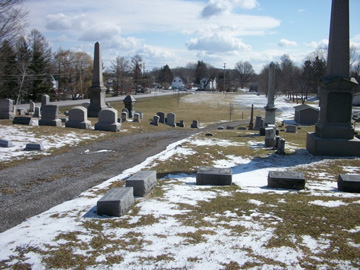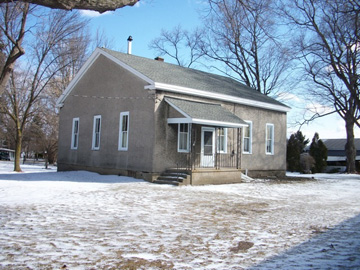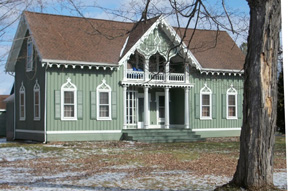Town of Bergen to commemorate 200th anniversary of formation in April
by Kristina Gabalski
 Looking east – Mt. Rest Cemetery at the intersection of Routes 19 and 262, the site of the April 13 ceremonies and, of Buell’s Corners, the original village settlement.Ceremonies at Mt. Rest Cemetery Saturday, April 13, will commemorate the 200th anniversary of the formation of the Town of Bergen.
Looking east – Mt. Rest Cemetery at the intersection of Routes 19 and 262, the site of the April 13 ceremonies and, of Buell’s Corners, the original village settlement.Ceremonies at Mt. Rest Cemetery Saturday, April 13, will commemorate the 200th anniversary of the formation of the Town of Bergen.
Town Historian Tom Tiefel says the event, which begins at 1 p.m., will include speeches by local and state legislators as well as Town Supervisor Don Cunningham.
Also, the program will include the American Legion Color Guard, music will be provided by the Byron-Bergen High School band and Sonia Catalino will sing “God Bless America.” Church bells at the Bergen and Stone Church Presbyterian Churches will ring and Tiefel adds refreshments will include,“… a birthday cake.”
The celebration is being held at the intersection of Route 19 and Route 262, on the grounds of the Mt. Rest Cemetery, Tiefel explains, because it is the site of the first settlement in the town.
A historical marker at the site states there was a tavern, general store, shoe shop, tailor shop, houses, and a church on the site which was known as Buell’s Corners in 1810 and later as Bergen Corners. The building of the railroad in the 1830s caused a shifting of the village settlement farther north on Route 19 where it is today.
A time capsule is being prepared to mark the bicentennial and a town tree will also be planted, Tiefel says.
Items are being collected at the Town Hall for the time capsule and organizers have drawn up a list of items which would be appropriate to include. Those items include pictures of current structures, business cards from local businesses, personal notes, coins, a school yearbook, home-pages of local websites, newspaper articles, the school calendar and obituaries, births and weddings for the year.
Tiefel says it’s exciting to be a part of the bicentennial organizing committee as well as to compile the time capsule – “no one of our generation will ever see it again. One hundred years from now when it is opened, our names will be in there and that’s neat.”
Special accommodations are also being made to help octogenarians in the town attend the celebration. Call Fred Ely at 494-1574 to make arrangements for a ride to and from the event.
 The Bergen Museum in the hamlet of Stone Church was built as a two-room school house in 1843 and last used as a school in 1957. The town opened it as a museum of local history in 1966. It will now be used to house a school house museum as well as artifacts from Stone Church. Other items in the collection will be moved to the Harford Livery Museum in the village, which will become the local history museum for the town. Tiefel, who says he failed high school history, grew up in Gates and moved to Bergen 19 years ago when he purchased the historic Dean Farmstead on North Bergen Road. His passion for history began when he learned that Lt. Thomas J. Dean was a soldier in the Civil War.
The Bergen Museum in the hamlet of Stone Church was built as a two-room school house in 1843 and last used as a school in 1957. The town opened it as a museum of local history in 1966. It will now be used to house a school house museum as well as artifacts from Stone Church. Other items in the collection will be moved to the Harford Livery Museum in the village, which will become the local history museum for the town. Tiefel, who says he failed high school history, grew up in Gates and moved to Bergen 19 years ago when he purchased the historic Dean Farmstead on North Bergen Road. His passion for history began when he learned that Lt. Thomas J. Dean was a soldier in the Civil War.
The Bergen community is excited about the upcoming celebration, Tiefel says. “It’s surreal to be in the position of historian in the midst of the bicentennial,” he explains, and notes the celebration is, “gaining momentum like a runaway train and I’m in the midst of it and it’s fun.”
Tiefel says one of the events in town history which stands out in his mind is the failure of the Housel Bank which occurred in 1929 before the beginning of the Stock Market crash. A sign was placed in the door on that day reading, “Closed for Voluntary Liquidation,” Tiefel says. Depositors lost $210,801.95 (eight cents on the dollar was returned to depositors in 1935). Residents of Bergen would later say the Depression started there – as it had the first bank that failed.
Recording memories provides historical view
My mother, Margaret P. Greene, lived in the Village of Bergen in the same house on Lake Street most of her life – from 1922-1989. In 1980, she wrote a collection of her memories of growing up in Bergen and vividly recounted the failure of the Housel Bank.
“I do remember the dark days when Housel’s Bank went under and the dire straights of many families,” she wrote. “We, as a family, did not happen to use the bank, but my brother had earnings there which he drew out the day before to buy his first car.”
That remarkably fortunate brother – Ransom Irving “Rip” Page, Jr. – went on to be a successful local businessman – as the founder and owner of Page Appliances in Spencerport.
She also wrote of monthly trips (1920s) to Creamery Road in Bergen with her dad, “… to fill dark green, two quart bottles with spring water, which came up from the ground in a pipe that never stopped running. This was especially fine water and a generation before provided the water for the Bergen Creamery where farmers sold their milk. Production was said to have been 900 pounds a week and was sent to Buffalo and Rochester for sale.”
 The Gifford-Walker House c. 1860 located in the Hamlet of North Bergen is listed on the National Register of Historic Places. It is an outstanding example of Gothic Revival architecture.The Cold Spring Creamery (incorporated in 1888), produced butter, and was badly damaged by fire in 1904, but was rebuilt a few months later. It’s believed the creamery was torn down in 1917 or 1918.
The Gifford-Walker House c. 1860 located in the Hamlet of North Bergen is listed on the National Register of Historic Places. It is an outstanding example of Gothic Revival architecture.The Cold Spring Creamery (incorporated in 1888), produced butter, and was badly damaged by fire in 1904, but was rebuilt a few months later. It’s believed the creamery was torn down in 1917 or 1918.
Tiefel says the days of World War II were also difficult ones for those in Bergen, when the presence of a U.S. military vehicle meant a family was being notified of the death of a loved one in combat.
In her memoirs, Margaret Greene also recalled life in Bergen at that time.
“After my day job in Rochester, I served as an airplane observer at the post on Standpipe Hill in the village. This post was manned by young and old residents for several years on a 24-hour-a-day basis. The Gas Rationing Board put me to work issuing ration books and we did this from the village school on specific evenings. Those of us who could, both young and old, went to the canning factory during peak season and worked evenings to assist in the food processing. The lack of new cars, gas, some foods and other necessities did not matter as we worried about our men and our country.”
Tiefel says he is busy working to establish the Harford Livery Museum in the village as the main historical museum for the town. The museum has been undergoing a transformation and Tiefel has built a replica of a carriage works inside and is working on replicas of other local businesses including Fisher and Son’s Drug Store.
“My goal for the exhibits is to have a three-dimensional picture of what life was like,” he says.
The former town museum in Stone Church, which once served as a two-room school, will be the site of a school house exhibit and include a room set aside for artifacts from the history of the hamlet.
Tiefel says he has been slowly moving items from Stone Church to the Harford Livery. “It’s a treasure trove of artifacts,” he says.
The Harford Livery Museum will also contain yearly rotating special exhibits, he adds.
“I’m passionate about Bergen,” Tiefel says. “I want to grow old here. There’s something about Bergen. It has a Mayberry feel to it.”
He especially enjoys working with Byron-Bergen Central students studying local history.
Tiefel says he would like fourth graders to be, “….blown away by this tiny town,” when they come to visit Harford Livery.
During this year’s Bergen Park Festival in June, the Harford Livery will be open to visitors. Tiefel says he is planning a re-opening celebration and dedication for the museum.


